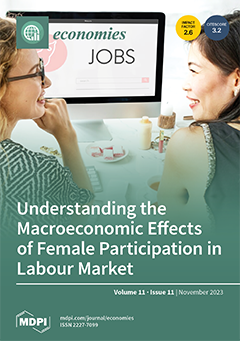Natural resource rent (NRR) can be a blessing for the economic growth of resource-rich economies but may cause environmental problems. The present research explores the effects of NRR, economic growth, trade openness (TO), and foreign direct investment (FDI) on the carbon intensities of
[...] Read more.
Natural resource rent (NRR) can be a blessing for the economic growth of resource-rich economies but may cause environmental problems. The present research explores the effects of NRR, economic growth, trade openness (TO), and foreign direct investment (FDI) on the carbon intensities of different sources of carbon emissions in Saudi Arabia from 1968 to 2021. The environmental Kuznets curve (EKC) is substantiated in the relationship between economic growth and the carbon intensities of gas emissions and cement emissions in the long run. The EKC is also validated in models of the carbon intensities of oil emissions, gas flaring emissions, and aggregated CO
2 emissions in the short run. TO reduces the carbon intensities of oil emissions, gas emissions, and cement emissions in the long run. FDI mitigates the carbon intensity of gas flaring emissions but increases the carbon intensity of cement emissions. NRR increases the carbon intensities of all investigated sources of emissions in a linear analysis. In a nonlinear analysis, increasing NRR increases and decreasing NRR reduces the carbon intensities of all sources of emissions except aggregated CO
2 emissions. In the short-run results, TO decreases the carbon intensity of gas flaring emissions and increases the carbon intensities of gas emissions and cement emissions. FDI decreases the carbon intensities of all sources of emissions. In a linear analysis, NRR reduces the carbon intensities of oil emissions and cement emissions and increases the carbon intensities of gas emissions and gas flaring emissions. In a nonlinear analysis, increasing NRR reduces the carbon intensity of cement emissions and increases the carbon intensities of gas emissions and gas flaring emissions. Moreover, decreasing NRR reduces the carbon intensities of gas emissions, gas flaring emissions, and aggregated CO
2 emissions and increases the carbon intensities of oil emissions and cement emissions. The effect of NRR is asymmetrical in models of the carbon intensities of aggregated CO
2 emissions, oil emissions, and gas flaring emissions and symmetrical in models of the carbon intensities of gas emissions and cement emissions.
Full article





